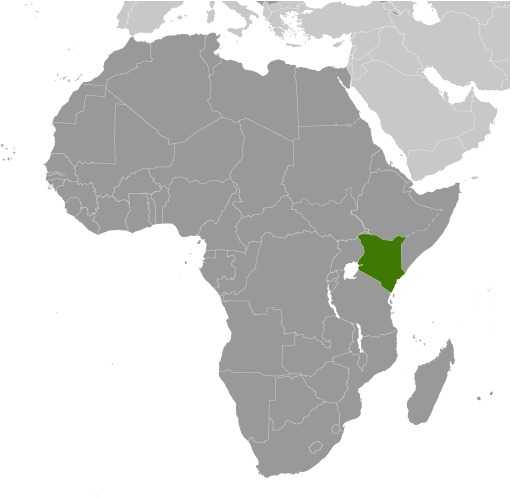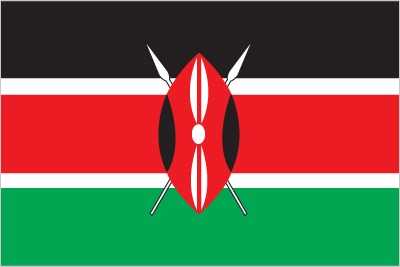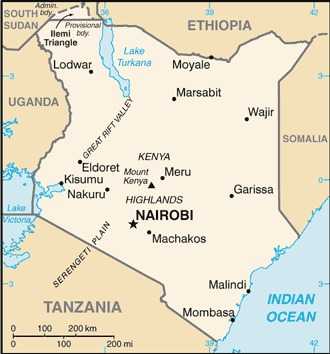Introduction
Background
Kenya gained independence from the United Kingdom in 1963. In 2010, Kenyans voted to adopt a new constitution that introduced additional checks and balances to executive power and devolved power and resources to 47 newly created counties.
Geography
Area
total: 580,367 sq km
land: 569,140 sq km
water: 11,227 sq km
Climate
varies from tropical along coast to arid in interior
Natural resources
limestone, soda ash, salt, gemstones, fluorspar, zinc, diatomite, gypsum, wildlife, hydropower
People and Society
Population
total: 58,246,378
male: 29,091,800
female: 29,154,578 (2024 est.)
Ethnic groups
Kikuyu 17.1%, Luhya 14.3%, Kalenjin 13.4%, Luo 10.7%, Kamba 9.8%, Somali 5.8%, Kisii 5.7%, Mijikenda 5.2%, Meru 4.2%, Maasai 2.5%, Turkana 2.1%, non-Kenyan 1%, other 8.2% (2019 est.)
Languages
English (official), Kiswahili (official), numerous indigenous languages
Religions
Christian 85.5% (Protestant 33.4%, Catholic 20.6%, Evangelical 20.4%, African Instituted Churches 7%, other Christian 4.1%), Muslim 10.9%, other 1.8%, none 1.6%, don't know/no answer 0.2% (2019 est.)
Population growth rate
2.06% (2024 est.)
Government
Government type
presidential republic
Capital
name: Nairobi
Executive branch
chief of state: President William RUTO (since 13 September 2022); note - the president is both chief of state and head of government
head of government: President William RUTO (since 13 September 2022)
Legislative branch
description: bicameral Parliament consists of:
Senate (68 seats; 47 members directly elected in single-seat constituencies by simple majority vote and 20 directly elected by proportional representation vote - 16 women, 2 representing youth, 2 representing the disabled, and one Senate speaker; members serve 5-year terms)
National Assembly (350 seats; 290 members directly elected in single-seat constituencies by simple majority vote, 47 women in single-seat constituencies elected by simple majority vote, and 12 members nominated by the National Assembly - 6 representing youth and 6 representing the disabled, and one Assembly speaker; members serve 5-year terms)
Economy
Economic overview
fast growing, third largest Sub-Saharan economy; strong agriculture sector with emerging services and tourism industries; IMF program to address current account and debt service challenges; business-friendly policies foster infrastructure investment, digital innovation and public-private partnerships; vulnerable to climate change-induced droughts
Real GDP (purchasing power parity)
$263.737 billion (2022 est.)
$251.545 billion (2021 est.)
$233.799 billion (2020 est.)
Real GDP per capita
$4,900 (2022 est.)
$4,700 (2021 est.)
$4,500 (2020 est.)
Agricultural products
sugarcane, milk, maize, tea, bananas, potatoes, cabbages, camel milk, cassava, mangoes/guavas (2022)
Industries
agriculture, transportation, services, manufacturing, construction, telecommunications, tourism, retail
Exports
$13.859 billion (2022 est.)
$11.825 billion (2021 est.)
$9.709 billion (2020 est.)
Exports - partners
US 10%, Uganda 9%, Pakistan 7%, Netherlands 7%, Rwanda 6% (2022)
Exports - commodities
tea, cut flowers, garments, coffee, titanium ore (2022)
Imports
$24.406 billion (2022 est.)
$21.853 billion (2021 est.)
$17.717 billion (2020 est.)
Imports - partners
China 26%, UAE 14%, India 11%, Malaysia 4%, Saudi Arabia 4% (2022)
Imports - commodities
refined petroleum, palm oil, garments, wheat, plastics (2022)
Exchange rates
Kenyan shillings (KES) per US dollar -
Exchange rates:
117.866 (2022 est.)
109.638 (2021 est.)
106.451 (2020 est.)
101.991 (2019 est.)
101.302 (2018 est.)
Page last updated: Wednesday, May 15, 2024




